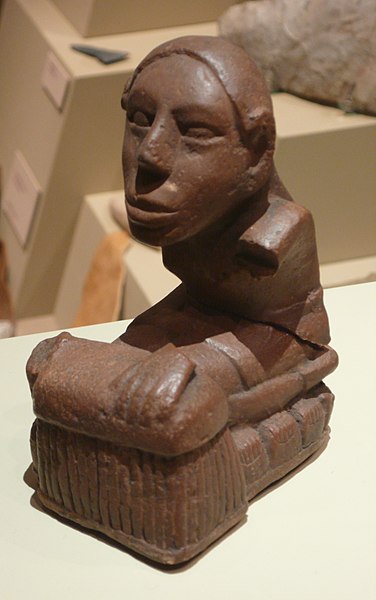.

Pre-Columbian figurine from Cahokia Mounds, site of largest indigenous city north of the Mesoamerican urban centers of Mexico, near present-day Collinsville, Illinois: photo by Tim Vickers, 3 January 2009
The tented outdoor bar and tables, the sparkling glints of diamond light created by the reflections dancing off the tall thin-stemmed champagne glasses, the cool jazz drifting from within and the impressive row of black limousines lined up out front, the magnificent spectacle of liberal wealth displaying itself in the midst of the decline of empire, the heavy unsmiling bodyguards eyeing the proceedings from a discreet vantage, the quietly imposing entourages of Governor and Senator, the bustling of the young stylishly outfitted help, the air of celebrity and of fine stock profile and of the cultural satiation of the permanently indulged, the privileged yet never quite satisfied, lay thick upon the foggy pall of night air enveloping the Avenue of the Possessed and Dispossessed, street of extreme wealth and extreme poverty uncomfortably superimposed, the ambient pungent aroma of unimaginably savoury and expertly prepared delicacies immaculately and discreetly served, the poor kept well out of the way, loitering without intent or lying upon cardboard pallets in the doorways of closed shops, as my shadow passed in disconnected contemplation...
Thinking of the paranoia of Constantine, the intense authoritarian efforts of Domitian and Constantine to maintain cohesion, to retain power, all for naught in the end, the black tide could not be resisted, the collapse was compelled onward by its own momentum, the overlayering of social strata, the proliferation of specialized economic roles, the rise of the information producers and analysts, the decline of real production on the part of the accumulators of crucial resources, the fragmentation of what had once been a whole into multiple distinct and incompatible social units, the increasing strain on the population at large, the dismembered remains of the victims of ritual sacrifice stacked in the dreaming mounds left after the mysterious fall of the dominant city of the Mississippian culture, Cahokia, largest urban center north of the great Mesoamerican complexes of Mexico, a London or Paris of pre-Columbian times, with its cruel falcon gods, its fictive kinship rituals, its terminated bureaucracies and lost chiefdom lineages and intricate class structures buried under a millennial burden of dirt and forgetfulness, the digits of the inhabitants of the mass graves locked eternally in a clawing position as they struggle forever to climb upward through the impossible weight from above ...
Thinking of the paranoia of Constantine, the intense authoritarian efforts of Domitian and Constantine to maintain cohesion, to retain power, all for naught in the end, the black tide could not be resisted, the collapse was compelled onward by its own momentum, the overlayering of social strata, the proliferation of specialized economic roles, the rise of the information producers and analysts, the decline of real production on the part of the accumulators of crucial resources, the fragmentation of what had once been a whole into multiple distinct and incompatible social units, the increasing strain on the population at large, the dismembered remains of the victims of ritual sacrifice stacked in the dreaming mounds left after the mysterious fall of the dominant city of the Mississippian culture, Cahokia, largest urban center north of the great Mesoamerican complexes of Mexico, a London or Paris of pre-Columbian times, with its cruel falcon gods, its fictive kinship rituals, its terminated bureaucracies and lost chiefdom lineages and intricate class structures buried under a millennial burden of dirt and forgetfulness, the digits of the inhabitants of the mass graves locked eternally in a clawing position as they struggle forever to climb upward through the impossible weight from above ...

Mound 72 at the Cahokia site, a ridge-top burial mound south of Monk's Mound, where archaeologists found the remains of a man in his forties who was probably an important Cahokian ruler. The man was buried on a bed of more than 20,000 marine-shell disc beads arranged in the shape of a falcon, with the bird's head appearing beneath and beside the man's head, and its wings and tail beneath his arms and leg. Of the nearly three hundred skeletons discovered in Mound 7, the majority were determined to be sacrificial victims (including four young males missing hands and skulls, and more than fifty young women in a single mass grave, the remains segregated in two layers separated by matting): photo by Carptrash, September 2001

St. Louis as seen from Monk's Mound, largest of the earthen structures at the Cahokia site: photo by Carptrash, September 2001



No comments:
Post a Comment